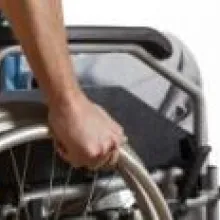UA Study Finds Huge Disparity in the Occurrence of Leg Amputations on Low-Income and Rural Patients with Type 2 Diabetes
People with low incomes or living in rural areas who have type 2 diabetes are significantly more likely to suffer the amputation of a lower extremity, largely due to limited access to preventive health care, according to research by the Southern Arizona Limb Salvage Alliance (SALSA) at the University of Arizona Department of Surgery.
The study, “A Diabetic Emergency One Million Feet Long: Disparities and Burdens of Illness among Diabetic Foot Ulcer Cases within Emergency Departments in the United States, 2006-2010,” published this month in the journal PLoS One, also found that a system for preventive care for those type 2 diabetes patients could cut national annual health-care costs by billions of dollars.

“We know now there are significant disparities in diabetes care, particularly within the lower extremities,” said David G. Armstrong, DPM, MD, PhD, UA professor of surgery and director and co-founder of SALSA. “But the great news about these shocking data is that with a little bit of energy, we can affect change and make a difference for these folks no matter where they live or how big their bank account is. This is true across a lot of problems in medicine and surgery. The difference here, however, is the steps are so easy. If we can just get a foot doctor out in those communities, then the risk can go down.”
In research spanning from 2006 through 2010, people living in rural areas were 51 percent more likely to have a major amputation (above the ankle) and 41 percent were more likely to die as a result of complications from diabetic foot ulcers than people living in urban areas where preventive care is more readily available. Medicaid beneficiaries low-income people with less access to preventive health care were 21 percent more likely to have a major amputation. During the research timeframe, more than 1 million cases of diabetic foot ulcers were seen in emergency departments throughout the United States, with about 83 percent of those resulting in admission to a hospital. The annual cost of treatment of those cases was about $8.8 billion, including about $1.9 billion per year in emergency department costs alone.

The findings suggest that by the time patients with diabetic foot ulcers are seen for the first time in an emergency department, the condition usually is so serious patients are hospitalized, as opposed to being treated and discharged. Once they get to that point, 3.4 percent of patients have a major amputation above the ankle, 7.1 percent have an amputation below the ankle and 1.8 percent die. The percentages increase significantly for low-income and rural patients.
However, preventive care could keep people out of emergency departments and hospitals, where they often face expensive treatment of diabetic foot ulcers that ultimately can result in amputation, Dr. Armstrong said.
“Diabetes is one of the big three non-communicable diseases, along with cancer and heart disease,” said Dr. Armstrong, who co-authored the article with Grant H. Skrepnek, MD, from the University of Oklahoma Health Sciences Center, and Joseph L. Mills, Sr., MD, from the Baylor College of Medicine.
Foot ulcers can develop when patients lose feeling in their lower extremities due to type 2 diabetes. Once a foot ulcer develops, Dr. Armstrong said, there's about a 50 percent chance the ulcer will become infected. Once infected, there is a high risk of amputation.
“We have a massive data set now and what we’re seeing is this problem is worse than we thought,” he said. “This problem is one of the most, if not the most, expensive complications of diabetes. It appears to be the most common reason people are admitted to the hospital. Not for a heart attack or a stroke, but remarkably for a foot problem. On top of that, when you start looking at other things like outpatient visits, this problem starts to take on serious intensity because we’re finding that this silent, sinister problem is more expensive than any of the five most-expensive-to-treat cancers in the United States.”
Dr. Armstrong suggested a three-tiered system for care could help reduce the disparity in outcomes for patients in outlying communities and for low-income patients.
He proposed creating a “level 3” type of care in which a doctor or nurse is in an outlying community with the training and knowledge to screen residents for type 2 diabetes and foot ulcers. A “level 2” facility could be based in a community hospital, where clinicians, vascular surgeons and podiatric surgeons also have a focus on the condition. And a “level 1” center would be in a facility like Banner – University Medical Center Tucson where the most complex cases could be treated.
Dr. Armstrong said the “synergy” at the UA Health Sciences, with its focus to address health disparities and the new clinical relationship with Banner Health, makes it feasible to create such a system and that would have a major impact on public health.
“One of the real promises of the Banner merger,” Dr. Armstrong said, “is we now may have the potential to get to people out in these outlying clinics and communities through logical development of systems and administration that we never were able to do in the past.”
The article concludes: “Development of better systems of urban and rural comprehensive outpatient diabetic foot services to provide earlier coordinated care for this frequently silent condition should be a major point of health-care emphasis, as it has the potential to reduce costs of emergency care and improve outcomes.”
Dr. Armstrong said, “People talk about low-hanging fruit. Well you can’t get any lower than the foot, and I think these data bear that out. It can make a difference in all our patients and it can make a difference in health disparities. I think this crosses all bank accounts, all ethnicities and all regions.”

